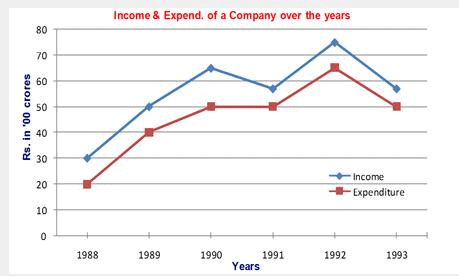Line Graph Examples with Questions | CSAT Preparation - UPSC PDF Download
Data interpretation Line Graphs
What is a Line Graph?
A modified version of Bar Graph representation is said to be a Line Graph. On connecting the upper points of two adjacent Bars of a Bar Graph we get a line and on further repeating this procedure with other Bars we get a Line Graph representation.
Solving a Line Graph question
Problems based on line graphs appear frequently in competitive exams having data interpretation as a component. Given below is a popular type of question asked from line graphs:
DIRECTIONS: Study the following graph carefully and answer the questions given below.
Example 1: In which of the following years was the percentage increase in income over the previous year the maximum?
1. 1989
2. 1990
3. 1991
4. 1992
Solution: Percentage increase= 100 × Increase/Previous year income. Option 3 is eliminated because there’s a decrease in income in 1991.
In 1989, percentage increase = 100 × 20/30 = 66.67%.
In 1990, percentage increase = 100 × 15/50 = 30%.
In 1992, percentage increase = 100 × 17.5/57.5 = 30.43%
(All the data is in Rs '00 cr.) Thus, Option 1 is the answer.
Alternatively,
For maximum % change, numerator should be the greatest and the denominator should be smallest. The numerator for 1989 is the greatest, while the denominator for the same year is the lowest as compared to corresponding figures for 1990 and 1992. So, you need not to find the exact percent increase of all the options given. Hence, answer is 1st option.
Example 2: What was the average income of the company over the years (approximately)?
1. 4500 cr
2. 500 cr
3. 5500 cr
4. 550 cr
Solution: Average in Rs '00 cr. = (30 + 50 +65 + 55 + 75 + 55)/6 = 55 =>Average= Rs 5500 cr. Hence, answer is 3rd option.
Example 3: What is the ratio of income to expenditure in the year 1990?
1. 1.2
2. 1.3
3. 1.1
4. 1.4
Solution: The income in the year 1990 is Rs. 6500 cr. and the expenditure is Rs. 5000 cr. Thus, the ratio in the year 1990 will be 6500/5000 = 1.3. Hence, answer is 2nd option.
Example 4: The total expenditure in 1988 and 1989 together was equal to the income in which of the following years?
1. 1900
2. 1991
3. 1993
4. None of these
Solution: The total expenditure in 1988 and 1989 together = Rs. 6000cr, which does not match with any other year's expenditure. So, the correct answer will be Option 4.
|
205 videos|264 docs|136 tests
|
FAQs on Line Graph Examples with Questions - CSAT Preparation - UPSC
| 1. What is a line graph? |  |
| 2. How do you interpret a line graph? |  |
| 3. What are the advantages of using a line graph? |  |
| 4. How can I create a line graph in Excel? |  |
| 5. What are some common mistakes to avoid when creating line graphs? |  |

















